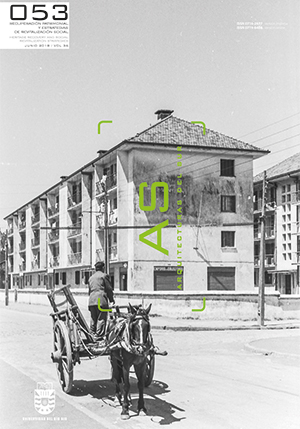A methodology for sustainable architectural rehabilitation: The case of Chiloé’s palafito stilt houses
El caso de los palafitos de Chiloé
DOI:
https://doi.org/10.22320/07196466.2018.36.053.04Keywords:
Patrimonio cultural, metodología, desarrollo sostenible, viviendas vernáculasAbstract
This article presents the methodology used and results achieved in a study on strategies of sustainable architectural rehabilitation in a group of stilt house dwellings (palafitos) in the city of Castro. In addition to the concept of “sustainable architectural rehabilitation”, environmental, social and economic, as well as architectural factors are addressed. They are evaluated qualitatively and quantitatively with the understanding that they come together to reaffirm the value and identity of a culture. The case that was chosen, stilt houses in Castro from the Pedro Montt 2 neighborhood, presents the opportunity to analyze the evolution of fragile pieces of architecture with heritage value that are destined to change uses or be adapted to the transformations that the city and society have experienced in recent decades. Data was collected, and different stilt house units were inspected with regards to three variables (environmental, physical and socioeconomic). Then intervention proposals were outlined that preserve local values and attributes and open opportunities to improve social and economic conditions for their inhabitants.
Downloads
References
BUSTAMANTE, Waldo. Guía de diseño para la eficiencia energética de la vivienda social. 1aed. Santiago: Grafhika Copy Center, 2009.
CEPAL. Comisión Económica para América Latina y el Caribe. Plan de acción regional para la implementación de la nueva agenda urbana en América Latina y El Caribe. 2016 – 2036 [en línea]. Santiago: Naciones Unidas, 2018 [Consultado 26 febrero 2018]. Disponible en: http:// conferencias.cepal.org/ciudades2017/Martes%203/Pdf/ Ricardo%20Jordan.pdf
GONZÁLEZ–VARAS, Ignacio. Patrimonio cultural. Conceptos, debates y problemas. 1aed. Madrid: Ediciones Cátedra, 2015.
HURTADO, Marcela. Turismo cultural en los Sitios Patrimonio Mundial (SPM): el papel de los stakeholders. Revista Márgenes, 2015, septiembre, vol.12, no 16, pp. 45-51.
ICOMOS. International council on monuments and sites. Carta del patrimonio vernáculo construido [en línea]. 1999a. [Consultado 10 enero 2018]. Disponible en: https://www.icomos.org/images/DOCUMENTS/Charters/vernacular_sp.pdf
ICOMOS. International council on monuments and sites. International cultural tourism chartes. Managing Tourism at Places of Heritage Significance [en línea]. 1999b. [Consultado 15 enero 2018]. Disponible en: https://www. icomos.org/charters/tourisme.pdf
JOKILEHTO, Jukka. Valores patrimoniales y valoración. Conversaciones. Revista de conservación [en línea]. 2016, julio, no 2, pp. 19-31. [Consultado 20 julio 2017]. Disponi- ble en: https://revistas.inah.gob.mx/index.php/conversaciones/article/view/10885/11754
LOBOS, Jorge (dir.). Archipiélago de Chiloé. Guía de arquitectura. 1aed. Sevilla: Escandón Impresores, 2006.
MANZI, Gabriela y MÁRQUEZ, Jaime. Arquitecturas eternas, leves, efímeras o precarias. CA. Revista oficial del colegio de arquitectos de Chile A.G., 1994, no 78, pp. 25-29.
MINVU. Ministerio de Vivienda y Urbanismo. Guía de recomendaciones para la reparación y puesta en valor de los palafitos de Castro [en línea]. Región de los Lagos: Departamento de Desarrollo Urbano e Infraestructura, Secretaría Regional Ministerial de Vivienda y Urbanismo, 2013. [Consultado 31 agosto 2017]. Disponible en: http:// www.serviuloslagos.cl/documentos/201306_Guia_Palafitos.pdf
MOLINA, María Catalina. Hacia paisajes banales. Estudio sobre normativas e imaginarios de la ciudad de Castro, isla de Chiloé, región de Los Lagos, Chile. Espacio Regional. Revista de estudios sociales [en línea], 2013, julio- diciembre, vol. 2, no 10, pp. 51-74. [Consultado 27 febrero 2018]. Disponible en: https://dialnet.unirioja.es/servlet/ articulo?codigo=4743410
MONJO-CARRIÓ, Juan y MALDONADO, Luis. Patologías y técnicas de intervención en estructuras arquitectónicas. 1aed. Madrid: Ediciones Munilla – Lería, 2001.
MONTECINOS, Hernán. Arquitectura de Chiloé. 1aed. Santiago: Facultad de Arquitectura y Urbanismo. Universidad de Chile, 1976.
PRATS, Llorenç. Concepto y gestión del patrimonio local. Cuadernos de Antropología Social [en línea]. 2005, julio, no21, pp.17-35. [Consultado 4 junio de 2018]. Disponible en: http://www.redalyc.org/pdf/1809/180913910002. pdf
RAPOPORT, Amos. Vivienda y cultura. Barcelona: Editorial Gustavo Gili, 1972.
ROS GARCÍA, Juan Manuel (coord.). Arquitectura biosalu- dable. Parámetros de habitabilidad. 1aed. Madrid: Ediciones Asimétricas, 2017.
RYBCZYNSKI, Witold. La casa. Historia de una idea. 10a ed. Donostia - San Sebastián: Nerea, 2015.
SERRA, Rafael y COCH, Helena. Arquitectura y energía natural. 1aed. Barcelona: Edicions UPC, 1995.
UNESCO. United Nations Educational, Scientific and Cultural Organization. Recommendation on the Historic Urban Landscape [en línea], 2011. [Consultado 15 enero 2018]. Disponible en: https://whc.unesco.org/uploads/ activities/documents/activity-638-98.pdf
UNESCO. United Nations Educational, Scientific and Cultural Organization. Recomendación sobre la Salvaguardia de la Cultura Tradicional y Popular [en línea], 1989. [Consultado 15 enero 2018]. Disponible en: http://portal. unesco.org/es/ev.php-URL_ID=13141&URL_DO=DO_ TOPIC&URL_SECTION=201.html
UNISDR. United Nations Office for Disaster Risk Reduction. Marco de Sendai para la Reducción del Riesgo de Desastres 2015–2030 [en línea], 2015. [Consultado 25 noviembre 2017]. Disponible en: https://www.unisdr.org/ files/43291_spanishsendaiframeworkfordisasterri.pdf
Downloads
Published
How to Cite
Issue
Section
License
The content of the articles published in each issue of Arquitecturas del Sur is the sole responsibility of the authors and does not necessarily represent the opinion of University of the Bío-Bío.
The authors will maintain their copyright; however, they will guarantee the journal the right to first publication and dissemination of their work. The publication of the article in Arquitecturas del Sur will be subject to the Creative Commons International license (CC BY-SA) that allows others to adapt: remix, transform and build on the material for any purpose, even commercially; share: copy and redistribute the material in any medium or format, as long as the authorship and first publication in this journal are acknowledged by citing them correctly, and their new contributions are under a license with the same terms.














 Programa de Información Científica/Concurso Fondos de Publicación de Revistas Científicas 2018/ Proyecto Mejoramiento de Visibilidad de Revistas UBB (Código:FP180007)
Programa de Información Científica/Concurso Fondos de Publicación de Revistas Científicas 2018/ Proyecto Mejoramiento de Visibilidad de Revistas UBB (Código:FP180007) 
